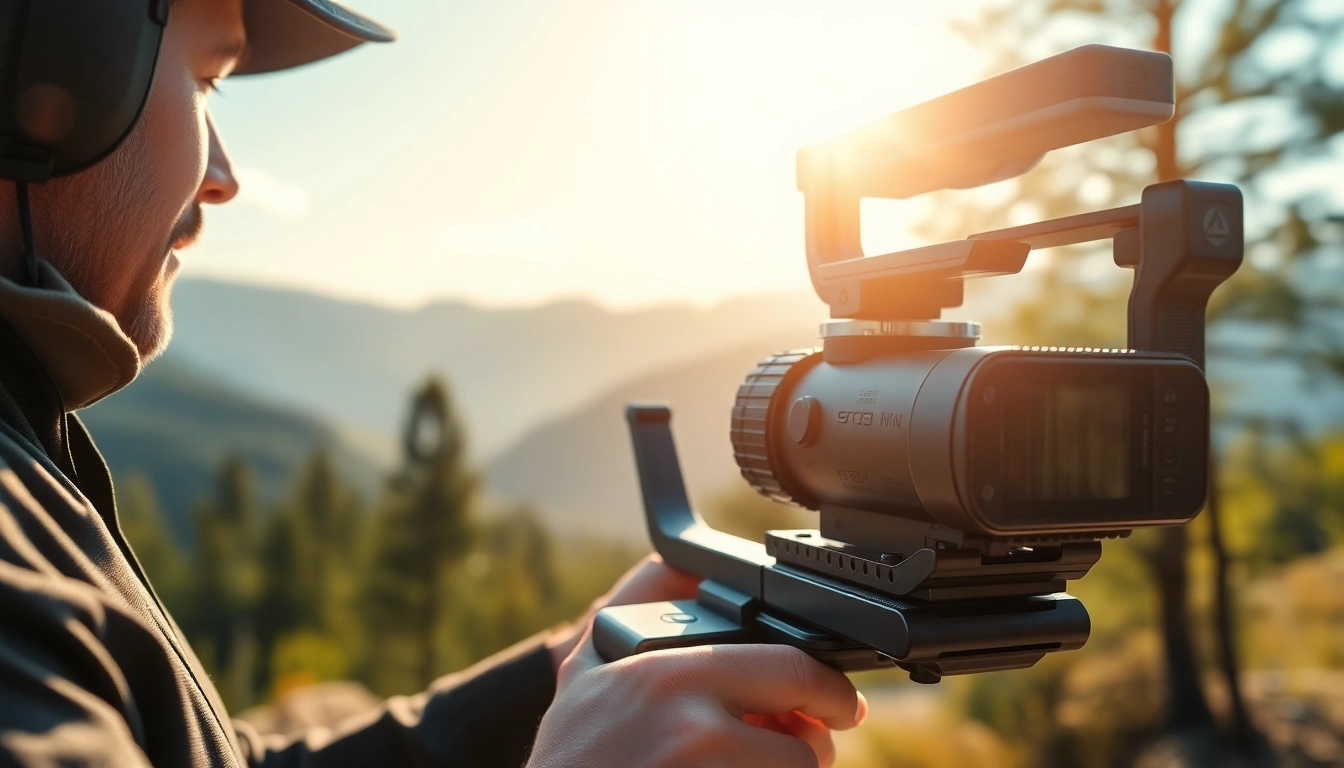Understanding Gimbal Camera Technology
What is a Gimbal Camera?
A gimbal camera is a specialized device designed to stabilize a camera or smartphone during motion. It uses motors and sensors to counteract unwanted movement along multiple axes, allowing for smooth, cinematic footage even in dynamic environments. By isolating the camera from motion and vibration, gimbals provide the perfect solution for filmmakers, videographers, and content creators who require fluid shots while maintaining the highest quality possible.
How Gimbal Camera Stabilization Works
Gimbal cameras operate on a sophisticated principle called stabilization. Most gimbals feature a 3-axis stabilization system, which allows movement along the tilt (up and down), pan (left and right), and roll (sideways) axes. Here’s how it works:
- Tilt Axis: Controls the camera’s vertical angle, allowing it to move up and down smoothly.
- Pan Axis: Enables horizontal movements, ensuring the camera can follow subjects without jitter.
- Roll Axis: Ensures the camera remains level even when the operator turns or tilts their body.
By using a combination of gyroscopic sensors and brushless motors, gimbal cameras continuously adjust to any movement, creating fluid and stable video footage. When the user walks, runs, or turns, these sensors detect changes and instruct the motors to counteract any undesired motion instantaneously.
Types of Gimbal Camera Available
There are several types of gimbal cameras available, each designed for specific applications.
- Handheld Gimbals: Ideal for mobile videographers, these are lightweight and portable and can be used for smartphones or lightweight mirrorless cameras.
- Motorized Gimbals: Often used for professional setups, they provide robust stabilization and can support heavier camera rigs. These gimbals come with multiple modes (like follow and lock modes) for varied shooting scenarios.
- Drone Gimbals: Integrated with drones, these gimbals ensure stable aerial shots and are designed to keep the camera level during flight.
- Smartphone Gimbals: Specifically engineered for smartphones, they are compact, user-friendly, and usually equipped with features like face tracking and object tracking.
Benefits of Using a Gimbal Camera
Smooth Video Footage
The primary advantage of using a gimbal camera is the ability to capture smooth video footage. Gimbal stabilization reduces shakiness and jitter, resulting in professional-quality video that is easy to watch. This is especially important for action sports or high-movement filming scenarios where traditional handheld methods would fail to deliver satisfactory results.
Versatile Shooting Options
Gimbal cameras provide filmmakers with versatile shooting options. With different modes like follow mode, lock mode, and vortex mode, users can achieve a wide range of creative shots. For instance, in follow mode, the camera smoothly tracks a subject’s movement, while lock mode holds the camera steady on a particular point, and vortex mode can create 360-degree cinematic spins.
Enhanced Creative Control
Using a gimbal camera allows for enhanced creative control in video production. Filmmakers can experiment with unique angles, transitions, and movements that would be challenging to accomplish without stabilization equipment. This opens up a world of storytelling opportunities, making every project distinct and visually appealing.
Choosing the Best Gimbal Camera for Your Setup
Consider Your Filming Style
When selecting a gimbal camera, it’s essential to consider your filming style. Are you capturing fast-paced action or tranquil landscapes? For action sports, a more sturdy motorized gimbal that can handle sudden movements would be ideal. Conversely, for gentle landscapes, a lightweight handheld gimbal could suffice. Understanding the context of your filming will guide you toward the right gimbal type.
Weight Capacity and Compatibility
Each gimbal camera has a weight capacity and is compatible with certain camera types. It’s vital to select a gimbal that can support your specific camera or smartphone as well as any additional accessories you may want to use, like microphones or lights. Check the specifications to ensure that the gimbal you choose matches your equipment’s weight and dimensions.
Budget Considerations for Gimbal Camera
Gimbals come with a wide range of pricing options, so determining your budget is crucial before you start shopping. Consider what features are essential for your projects and how much you’re willing to invest. Remember that while some budget options may work for beginners, you might need to invest more for high-performance gimbals suited for professional videography.
Tips for Mastering Your Gimbal Camera
Best Techniques for Stabilization
To get the most out of your gimbal camera, employ the following techniques:
- Use the Right Grip: Hold the gimbal close to your body to stabilize your movements. The more you stabilize your body, the easier it will be for the gimbal to do its job.
- Practice Walking Techniques: When moving with the gimbal, practice a smooth walking technique, placing your feet heel-to-toe to minimize shake.
- Utilize the Gimbal Modes: Familiarize yourself with various gimbal modes and use them accordingly to enhance shot composition.
Settings to Optimize Performance
Adjusting the gimbal settings can significantly improve performance. Make sure to calibrate your gimbal before each use and pay attention to settings such as responsiveness and deadband options, which control the sensitivity of the movements. Tuning these settings based on your shooting style and environment can lead to smoother results.
Common Mistakes to Avoid
When using a gimbal camera, avoid common mistakes that could affect your footage quality:
- Neglecting Calibration: Always calibrate your gimbal before use, as failure to do so can lead to erratic movement.
- Overloading the Gimbal: Exceeding the weight limit of your gimbal compromises its performance; always check weight capacities before attaching your camera.
- Forgetting Battery Management: A gimbal without sufficient battery power will not operate correctly. Always ensure batteries are charged before filming.
Maintenance and Care for Your Gimbal Camera
Cleaning and Storage Tips
To extend the life of your gimbal camera, regular maintenance is essential. After each shoot, clean the lenses, gimbal motors, and arms with a microfiber cloth. Avoid exposing your gimbal to dust and moisture, and store it in a padded bag when not in use to protect it from impact.
When to Replace Parts
Pay attention to the performance of your gimbal. If you notice any unusual noises or unresponsive motors, it may be time to inspect or replace parts. Regularly check the firmware for updates that can enhance performance. Replacement parts should match the manufacturer’s specifications to maintain optimal function.
Upgrading Your Gimbal Camera
As technology evolves, there may come a time when upgrading your gimbal camera is necessary. Look for models with enhanced features, such as improved motors, longer battery life, or added connectivity options. Staying updated with the latest technology can significantly benefit your filming quality and productivity.



